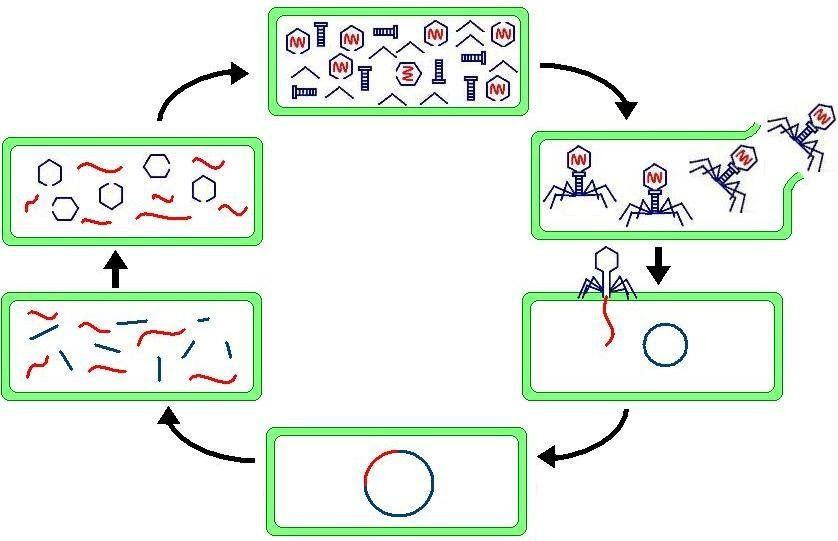
What is the three step process of the phage infection cycle?
Answer
385.5k+ views
Hint: Viruses are submicroscopic infectious particles. They are only living inside the body of the host and are considered non-living in the environment. They are highly infectious and can infect animals, plants and microorganisms too. They are present in all ecosystems and more than 9000 species of viruses have been discovered so far.
Complete answer:
A bacteriophage, also known as a phage, is a type of virus that infects bacteria. Bacteriophages, like other viruses, have a wide range of shapes and genetic material. Phage genomes can be made up of DNA or RNA and can have as few as four genes or as many as hundreds. They infect all the life forms from animals to plants to microorganisms also.
Viruses only consist of genetic material either DNA or RNA, protein coat known as capsid and outside envelopes of lipids. A bacteriophage's capsid can be icosahedral, filamentous, or head-tail shaped. Phage and their close relatives appear to have a unique head-tail structure (and is not found in eukaryotic viruses). When a host cell is infected, it forcefully produces thousands of copies of the original virus. They spread in many ways like vectors, blood sucking animals, air, faecal oral routes, etc.
The term "viral replication" refers to the formation of biological viruses in the target host cells during the infection process. Before viruses can replicate, they must first penetrate and enter the cell. Attachment, penetration, uncoating, replication, assembly, and release are all steps in the virus replication cycle that most productive viral infections follow.
The three step process of phage infection cycle are:
1. Attachment and penetration- Phage substance binds to the exterior of the bacteria and injects the DNA into the cells,
2. Uncoating and biosynthesis- Phage DNA molecules are replicated by particular phage enzymes which are coded by the genes of the phage chromosome,
3. Maturation, and release- New phage substances are gathered and released from a bacteria, other phage genes direct the synthesis of the protein component of capsid.

Note:
Bacteriophages in the environment can cause cheese starter cultures to fail to ferment. Mixed-strain starter cultures and culture rotation regimes can be used to avoid this. Genetic engineering of culture microbes, particularly Lactococcus lactis and Streptococcus thermophilus, has been studied for phage resistance genetic analysis and modification.
Complete answer:
A bacteriophage, also known as a phage, is a type of virus that infects bacteria. Bacteriophages, like other viruses, have a wide range of shapes and genetic material. Phage genomes can be made up of DNA or RNA and can have as few as four genes or as many as hundreds. They infect all the life forms from animals to plants to microorganisms also.
Viruses only consist of genetic material either DNA or RNA, protein coat known as capsid and outside envelopes of lipids. A bacteriophage's capsid can be icosahedral, filamentous, or head-tail shaped. Phage and their close relatives appear to have a unique head-tail structure (and is not found in eukaryotic viruses). When a host cell is infected, it forcefully produces thousands of copies of the original virus. They spread in many ways like vectors, blood sucking animals, air, faecal oral routes, etc.
The term "viral replication" refers to the formation of biological viruses in the target host cells during the infection process. Before viruses can replicate, they must first penetrate and enter the cell. Attachment, penetration, uncoating, replication, assembly, and release are all steps in the virus replication cycle that most productive viral infections follow.
The three step process of phage infection cycle are:
1. Attachment and penetration- Phage substance binds to the exterior of the bacteria and injects the DNA into the cells,
2. Uncoating and biosynthesis- Phage DNA molecules are replicated by particular phage enzymes which are coded by the genes of the phage chromosome,
3. Maturation, and release- New phage substances are gathered and released from a bacteria, other phage genes direct the synthesis of the protein component of capsid.

Note:
Bacteriophages in the environment can cause cheese starter cultures to fail to ferment. Mixed-strain starter cultures and culture rotation regimes can be used to avoid this. Genetic engineering of culture microbes, particularly Lactococcus lactis and Streptococcus thermophilus, has been studied for phage resistance genetic analysis and modification.
Latest Vedantu courses for you
Grade 11 Science PCM | CBSE | SCHOOL | English
CBSE (2025-26)
School Full course for CBSE students
₹41,848 per year
Recently Updated Pages
Express the following as a fraction and simplify a class 7 maths CBSE

The length and width of a rectangle are in ratio of class 7 maths CBSE

The ratio of the income to the expenditure of a family class 7 maths CBSE

How do you write 025 million in scientific notatio class 7 maths CBSE

How do you convert 295 meters per second to kilometers class 7 maths CBSE

Write the following in Roman numerals 25819 class 7 maths CBSE

Trending doubts
Give 10 examples of unisexual and bisexual flowers

Draw a labelled sketch of the human eye class 12 physics CBSE

Differentiate between homogeneous and heterogeneous class 12 chemistry CBSE

Differentiate between insitu conservation and exsitu class 12 biology CBSE

What are the major means of transport Explain each class 12 social science CBSE

Franz thinks Will they make them sing in German even class 12 english CBSE




